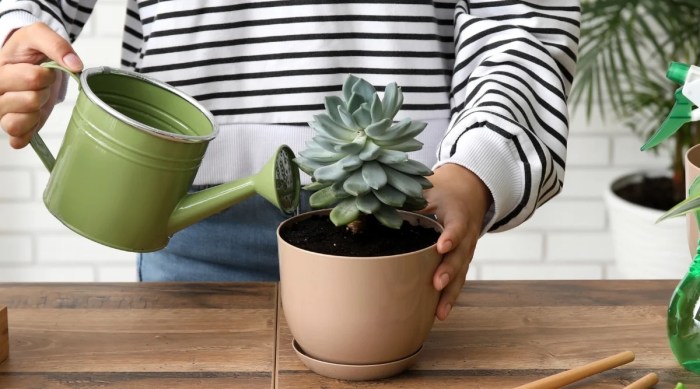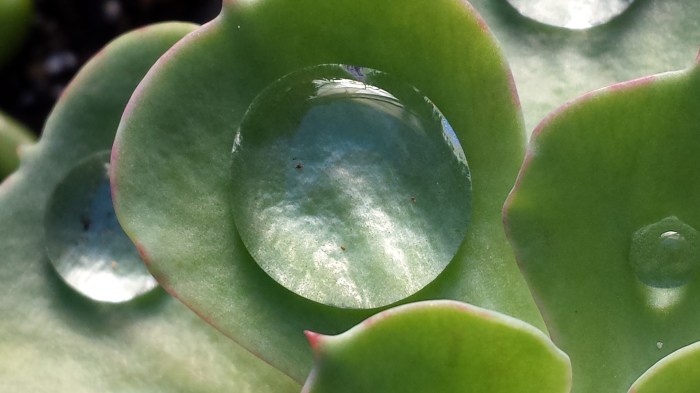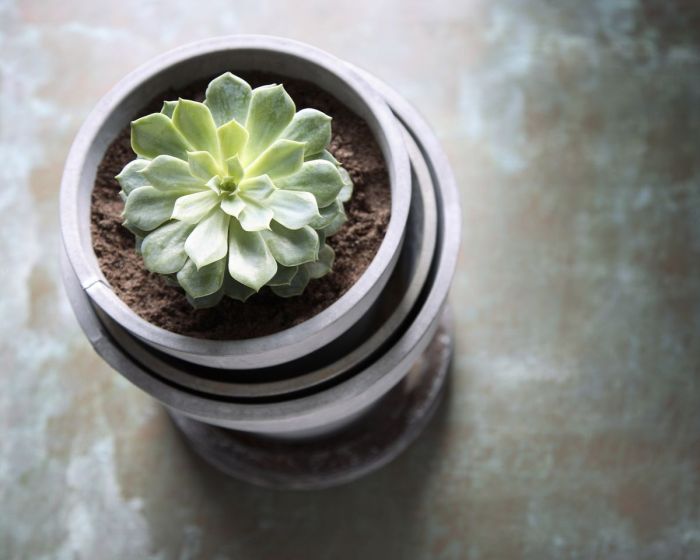How to Water Succulent Plants
Understanding Succulent Watering Needs: How To Water Succulent Plants

Source: epicgardening.com
How to water succulent plants – Proper watering is crucial for the health and longevity of succulent plants. Their unique water storage capabilities mean they require a different approach than most other houseplants. Understanding their needs, considering factors like climate, pot type, and season, is key to preventing both underwatering and overwatering.
Factors Influencing Watering Frequency, How to water succulent plants
Several factors influence how often you need to water your succulents. These include climate, pot size, soil type, and the season.
- Climate: Hot, dry climates will require more frequent watering than cooler, humid ones. Succulents in arid environments will dry out faster.
- Pot Size: Smaller pots dry out quicker than larger ones. Smaller pots have a smaller volume of soil to retain moisture.
- Soil Type: Well-draining soil is essential. A soil mix that retains too much moisture can lead to root rot. Fast-draining cactus and succulent mixes are ideal.
- Season: Succulents need less water during winter dormancy and more during active growth in spring and summer.
Signs of Underwatered and Overwatered Succulents
Recognizing the signs of underwatering and overwatering is vital for timely intervention. The following table illustrates the key differences.
| Image Description | Symptoms | Causes | Solutions |
|---|---|---|---|
| Shriveled, wrinkled leaves; dull leaf color; soil completely dry | Leaves appear shriveled, wrinkled, and lack turgor; soil is bone dry; leaves may be brittle | Insufficient watering; prolonged drought; very porous soil | Thoroughly soak the soil, allowing excess water to drain. Increase watering frequency as needed. |
| Soft, mushy leaves; yellowing or browning; foul odor from soil | Leaves become soft, mushy, and may appear discolored (yellow or brown); stems may be soft; soil may have a foul odor | Overwatering; poor drainage; compacted soil; fungal or bacterial infections | Allow the soil to dry completely. Repot in well-draining soil. Remove any affected leaves or stems. |
Watering Needs of Different Succulent Types
While the general principles apply, different succulent types have slightly varying water requirements. For example, Echeverias tend to prefer slightly drier conditions than Haworthias, which tolerate slightly more moisture.
- Echeveria: These succulents are relatively drought-tolerant and prefer infrequent, thorough watering.
- Haworthia: These succulents are more tolerant of slightly moist soil compared to Echeverias but still need well-draining soil.
- Sedum: Sedums are generally hardy and drought-tolerant, similar to Echeverias.
Watering Methods and Techniques
Choosing the right watering method can significantly impact your succulent’s health. The “soak and dry” method is a popular choice, but top and bottom watering also have their advantages.
The Soak and Dry Method
The “soak and dry” method involves thoroughly soaking the soil until water drains from the drainage holes, then allowing the soil to dry out completely before watering again. This mimics the natural rainfall patterns in succulent habitats.
- Advantages: Encourages deep root growth, prevents shallow rooting, reduces the risk of overwatering.
- Disadvantages: Requires careful monitoring of soil moisture; may be less convenient for larger collections.
Top Watering Technique
Top watering involves pouring water directly onto the soil surface. It’s crucial to ensure even moisture distribution and avoid getting water on the leaves, which can cause rot.
- Slowly pour water around the base of the plant, avoiding the leaves.
- Continue watering until water drains from the drainage holes.
- Allow excess water to drain completely; do not let the plant sit in standing water.
Bottom Watering Technique

Source: thesucculenteclectic.com
Bottom watering involves placing the pot in a tray of water, allowing the soil to absorb moisture from the bottom up. This method is particularly useful for preventing overwatering and promoting even moisture distribution.
Illustration: Imagine a terracotta pot with drainage holes sitting in a shallow tray filled with a few inches of water. The water level should be below the drainage holes. The soil will absorb water from the bottom, providing even hydration without the risk of excess water accumulating at the top.
Choosing the Right Potting Mix and Container
The right potting mix and container are crucial for ensuring proper drainage and preventing waterlogging, which is detrimental to succulents.
Importance of Well-Draining Soil
Well-draining soil is paramount for succulent health. It allows excess water to drain freely, preventing root rot. Suitable potting mixes often include a blend of cactus and succulent potting mix, perlite, pumice, and coarse sand.
- Cactus and succulent potting mix: This commercially available mix provides good drainage and aeration.
- Perlite: Adds aeration and drainage to the soil.
- Pumice: A volcanic rock that improves drainage and aeration.
Role of Pot Size and Material
Pot size and material influence water retention. Terracotta pots are porous and allow for faster evaporation, while plastic pots retain moisture for longer periods.
- Terracotta pots: These pots are porous and allow for better air circulation, reducing the risk of overwatering. However, they dry out more quickly.
- Plastic pots: These pots retain moisture longer, requiring less frequent watering. However, they can increase the risk of overwatering if not monitored carefully.
Pot Types, Water Retention, and Suitability
| Pot Type | Water Retention | Suitability for Succulents |
|---|---|---|
| Terracotta | Low | Suitable for most succulents, especially those that prefer drier conditions. |
| Plastic | High | Suitable for succulents that tolerate slightly more moisture, but requires careful monitoring. |
| Ceramic (glazed) | Moderate | Suitable for many succulents, providing a balance between drainage and moisture retention. |
Seasonal Watering Adjustments
Watering frequency should be adjusted based on the season, temperature, and sunlight exposure. Succulents require less water during dormancy and more during their active growth phase.
Seasonal Watering Changes

Source: futurecdn.net
Succulents enter a period of dormancy in winter, requiring significantly less water. During spring and summer, their growth is more active, necessitating more frequent watering.
- Spring: Gradually increase watering frequency as temperatures rise and growth resumes.
- Summer: Water more frequently, especially during hot and dry periods.
- Autumn: Gradually reduce watering frequency as temperatures decrease.
- Winter: Water sparingly or not at all, depending on the climate and specific succulent type.
Temperature and Sunlight’s Influence
Higher temperatures and increased sunlight intensity increase the rate of evaporation, requiring more frequent watering. Conversely, lower temperatures and less sunlight reduce evaporation, necessitating less frequent watering.
Proper succulent watering involves allowing the soil to dry out completely between waterings, preventing root rot. Determining the precise frequency depends on the specific plant; for instance, to understand the ideal watering schedule for a common succulent, you might find it helpful to consult a guide on how often should you water an aloe plant , as aloe vera is a popular succulent.
Remember, consistent, well-draining soil is key to healthy succulent growth regardless of species.
Echeveria Seasonal Watering Schedule
| Season | Frequency | Amount of Water |
|---|---|---|
| Spring | Every 1-2 weeks | Thorough soaking, allowing excess water to drain |
| Summer | Every 7-10 days | Thorough soaking, allowing excess water to drain |
| Autumn | Every 2-3 weeks | Thorough soaking, allowing excess water to drain |
| Winter | Every 4-6 weeks or less | Minimal watering, only if soil is completely dry |
Troubleshooting Common Watering Problems
Despite best efforts, watering issues can still arise. Recognizing and addressing these problems promptly is key to maintaining healthy succulents.
Solutions for Common Problems
- Root rot: Symptoms include mushy leaves, foul odor from soil. Solutions include repotting in fresh, well-draining soil, removing any rotten roots.
- Leaf drop: Can be caused by both underwatering and overwatering. Check the soil moisture and adjust watering accordingly.
Reviving Underwatered or Overwatered Succulents
Underwatered succulents can be revived by thoroughly soaking the soil. Overwatered succulents require allowing the soil to dry completely and potentially repotting.
Troubleshooting Guide
| Problem | Cause | Solution | Preventative Measures |
|---|---|---|---|
| Root rot | Overwatering, poor drainage | Repot in well-draining soil, remove affected roots | Use well-draining soil, ensure proper drainage |
| Leaf drop | Underwatering, overwatering, temperature fluctuations | Adjust watering frequency, provide stable temperatures | Monitor soil moisture regularly, provide consistent conditions |
| Leggy growth | Insufficient sunlight | Increase sunlight exposure | Place succulents in a sunny location |
Popular Questions
Can I use tap water to water my succulents?
Tap water is generally acceptable, but letting it sit out for 24 hours to allow chlorine to dissipate is beneficial. Avoid using very hard water.
How often should I check the soil moisture?
Check the soil moisture before watering. Stick your finger about an inch into the soil; if it feels dry, it’s time to water.
What are the signs of a root rot?
Mushy, brown roots and a foul odor are indicative of root rot. Leaves may also appear mushy and fall off easily.
My succulent leaves are shriveling, what should I do?
This is usually a sign of underwatering. Water thoroughly and monitor for improvement. If the soil is already moist, other factors may be at play.




















